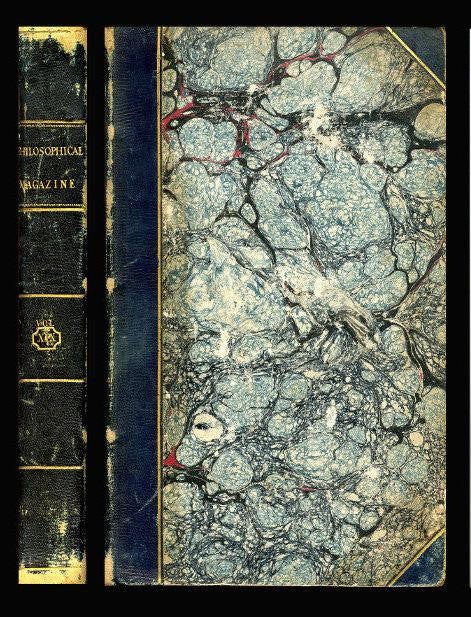On the supposed Chemical Affinity of the Elements of Atmospheric Air: with Remarks upon Dr. Thomson's Observations on the Subject, (Dalton) with Osteological Description of the one-horned Rhinoceros (Cuvier) with Account of an Aerostatic Voyage performed by Messrs. Guy-Lussac and Biot (Guy-Lussac and Biot) in The London, Edinburgh, and Dublin Philosophical Magazine and Journal of Science, 1804, pp. 79-83; pp. 350-354; pp. 371-379
London: Alexander Tilloch, 1804. 1st Edition. BOUND FIRST EDITION OF A LETTER ON THE ATOMIC THEORY IN CHEMISTRY FROM JOHN DALTON to Alexander Tilloch, founder of the journal in which this paper is published. Also included are papers of import by Gay-Lussac, Biot, and Cuvier.
John Dalton (1766-1844) was an English chemist, meteorologist, and physicist best known for his pioneering work in the development of modern atomic theory, the atomic theory in chemistry.
“Dalton applied the Laws of Conservation of Mass and Definite Composition to explain his Atomic Theory. He developed the chemical theory in 1803 and told Thomas Thomson, University of Edinburgh, about it in 1804” (Greenberg, A Chemical History, 172).
This paper is Dalton’s response to a conclusion the chemist and professor Thomas Thomson leveled regarding Dalton’s Atomic Theory; specifically: in the 2nd edition of his influential A System of Chemistry, Thomson wrote “that air is a chemical compound”; he then offered four reasons for his conclusion.
Dalton believed that he had already well-proven “the absurdity of the notion of atmospherical air being a chemical compound of azotic and oxygens gases” (Dalton, On the Supposed, 19, 1804, p. 79). The object of the Dalton paper offered here, then, is to show the “insufficiency” of Thomson’s four reasons; to do so, Dalton debunks each of Thomson’s four ‘reasons’ one by one.
ALSO INCLUDED: An exceedingly rare first edition in English of Jean-Baptiste Biot's paper, "Account of an Aerostatic Voyage”, describing his landmark balloon ascent with Louis-Joseph Gay-Lussac. The scientific readings that Biot and Gay-Lussac took during their ascent established that the Earth's magnetic field extends into the atmosphere. "The ascent was notable in that it was undertaken entirely for scientific purposes. The primary purpose was to find whether the magnetic intensity of the earth decreased at great altitudes, as had been suggested by Horace de Saussure's experiments in the Alps. From their experiments, in which they timed the oscillations of a magnetized needle at various altitudes, Biot and Gay-Lussac concluded that up to 4000 meters there was not change" (DSB, II, p. 134-135).
ALSO INCLUDED: "Osteological Description of the one-horned Rhinoceros" is the first English edition of the first part of an important paper by the celebrated zoologist and naturalist Georges Cuvier on the one-horned rhinoceros (one-horned Indian rhinoceros; Rhinoceros unicornis). It has been said that Georges Cuvier possessed one of the finest minds in history. Almost single-handedly, he founded vertebrate paleontology as a scientific discipline and created the comparative method of organismal biology, an incredibly powerful tool. It was Cuvier who firmly established the fact of the extinction of past life forms. Item #815
CONDITION & DETAILS: London: Alexander Tilloch. Complete volume. 8vo. (8.25 x 5.25 inches). [4], 400 pages. Illustration: Nine copper-engraved plates with light to moderate age toning and foxing. Tightly and very solidly bound in contemporary quarter calf over marbled boards. Gilt-lettered and ruled at the spine. The leather on spine is a bit scuffed and the spine tips are rubbed. Binding is tight and sturdy and overall in very good condition. Interior: Title page is moderately foxed. Light to moderate foxing from preliminaries through page 20; moderate foxing on the final few plates. The remainder of interior, including all papers of import, is very clean. Very good condition.
Price: $375.00

